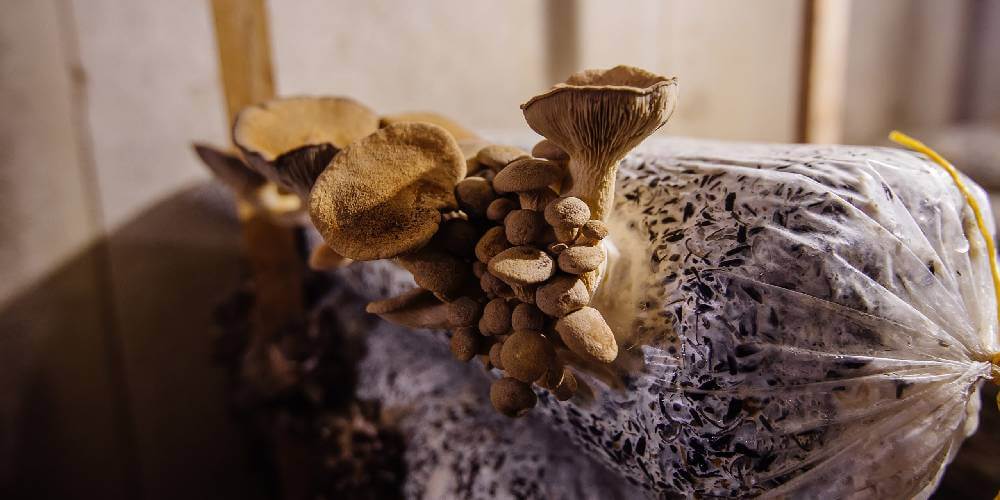Key Takeaways
- Understanding mushroom substrates is essential for successful cultivation the right substrate can significantly influence yield and growth rate.
- Different mushroom species require different substrates, so knowing your mushroom type is crucial for selecting the best substrate.
- Proper preparation and sterilization of the substrate are vital to prevent contamination and ensure healthy mushroom growth.
- Supplementing your substrate can boost nutrients and enhance mushroom growth, but it must be done carefully to avoid contamination.
- Choosing the right environment and conditions for your substrate will maximize your chances of a successful mushroom crop.
What is a Mushroom Substrate?
A mushroom substrate is the organic material used to support the growth of mushrooms. Unlike plants, mushrooms don’t have chlorophyll, so they can’t photosynthesize. Instead, they rely on a substrate to provide the necessary nutrients. The substrate serves as a food source and environment where mushrooms can thrive, allowing them to absorb nutrients and moisture essential for their development.
Common Types of Mushroom Substrates
Different types of mushrooms thrive on different substrates. Understanding the relationship between the mushroom species and their preferred substrate is key to a successful harvest. Here are some of the most common substrates used in mushroom cultivation:
-
Straw
- Widely used for growing oyster mushrooms, straw is a cost-effective and readily available substrate. It provides a good balance of nutrients, moisture retention, and aeration, making it ideal for fast-growing species.
-
Wood Chips and Sawdust
- Hardwood chips and sawdust are excellent substrates for species like shiitake and lion’s mane. These substrates mimic the natural environment of wood-loving mushrooms and provide the necessary lignin and cellulose for their growth.
-
Composted Manure
- Composted horse or cow manure is often used for growing button mushrooms. The composting process breaks down the organic matter, creating a nutrient-rich environment for mushrooms to flourish.
-
Coco Coir and Vermiculite
- Coco coir, derived from coconut husks, and vermiculite, a mineral that expands when heated, are combined to create a substrate for growing a variety of mushrooms. This mixture is particularly popular in indoor cultivation due to its cleanliness and ease of use.
-
Coffee Grounds
- A sustainable option, coffee grounds are rich in nitrogen and provide a suitable environment for growing oyster mushrooms. Reusing coffee grounds not only benefits your mushroom crop but also contributes to waste reduction.
-
Enriched Soils
- Enriched soils, often supplemented with compost or manure, can be used for morels and other wild mushrooms. These substrates replicate the natural forest floor, providing a complex environment for mycelium growth.

Choosing the Right Substrate for Your Mushroom Species
Selecting the right substrate depends on the type of mushroom you want to grow. Each species has specific nutritional needs and environmental preferences. Here’s a quick guide to help you match the right substrate to your mushroom species:
- Oyster Mushrooms: Thrive on straw, coffee grounds, or sawdust.
- Shiitake Mushrooms: Prefer hardwood sawdust, wood chips, or logs.
- Button Mushrooms: Grow well on composted manure or enriched soils.
- Lion’s Mane: Favors hardwood sawdust or a mixture of sawdust and wood chips.
- Reishi Mushrooms: Best grown on hardwood logs or sawdust.
How to Prepare Your Substrate
Preparation is key to a successful mushroom crop. A properly prepared substrate will provide the right balance of nutrients, moisture, and aeration for mushroom mycelium to colonize and fruit. Here’s a step-by-step guide on how to prepare your substrate:
-
Chop and Pasteurize
- For substrates like straw or wood chips, chopping the material into small pieces helps increase the surface area for mycelium growth. Pasteurization, typically done by heating the substrate to 160-180°F for an hour, kills off unwanted microbes while preserving beneficial organisms.
-
Hydration
- The substrate needs to be adequately hydrated but not waterlogged. A good rule of thumb is to squeeze the substrate; if a few drops of water come out, it’s just right. Too much water can lead to anaerobic conditions, which hinder mycelium growth.
-
Mix and Supplement
- Mixing different substrates can create a richer environment. For instance, combining sawdust with coffee grounds or straw can provide a balanced diet for your mushrooms. Additionally, supplements like bran, gypsum, or worm castings can be added to boost nutrient content.
-
Sterilization
- For high-risk substrates prone to contamination, such as grain, sterilization is essential. This process involves autoclaving or pressure cooking the substrate at 250°F for 90 minutes to eliminate all microorganisms.
-
Cooling and Inoculation
- Once pasteurized or sterilized, allow the substrate to cool before inoculating with mushroom spawn. Inoculation involves mixing the spawn evenly into the substrate, ensuring that the mycelium has multiple points from which to start colonizing.
The Role of Supplements in Mushroom Substrates
While basic substrates can support mushroom growth, supplements can significantly enhance productivity. However, supplementing your substrate comes with risks, as it can increase the chance of contamination. Understanding the right balance and how to apply these supplements is crucial.
-
Nitrogen-Rich Additives
- Bran, soybean meal, or alfalfa can be added to increase the nitrogen content in your substrate, which is especially beneficial for fast-growing mushrooms like oysters. However, high nitrogen levels can also attract competing molds, so pasteurization is recommended.
-
Calcium and pH Buffers
- Gypsum and lime are commonly used to balance the pH of the substrate. Most mushrooms prefer a slightly acidic to neutral pH (5.5 to 7.0). Gypsum not only buffers pH but also adds calcium and sulfur, which are beneficial for mycelium growth.
-
Carbohydrates and Sugars
- Adding sugars or carbohydrates like malt extract or dextrose can provide a quick energy source for the mycelium. However, these should be used sparingly, as they can lead to bacterial growth if not properly managed.
Contamination: Prevention and Management
Contamination is the bane of mushroom growers. The warm, moist environment required for mushroom cultivation also attracts unwanted molds, bacteria, and pests. Prevention is your best defense against contamination, but understanding how to manage it when it occurs is equally important.
-
Clean Work Environment
- Always work in a clean, sterile environment when handling substrates and inoculating spawn. This includes wearing gloves, using alcohol wipes on surfaces, and avoiding contact with unsterilized materials.
-
Proper Sterilization
- High-risk substrates, such as grains, should be thoroughly sterilized to kill any latent contaminants. For lower-risk substrates, pasteurization is typically sufficient.
-
Monitor Humidity and Temperature
- Maintaining the right humidity and temperature levels in your grow space is essential. High humidity promotes mushroom growth, but excess moisture can lead to bacterial contamination. Similarly, keeping temperatures within the optimal range for your species reduces the risk of molds.
-
Identify and Remove Contaminants
- Regularly inspect your growing environment for signs of contamination, such as discolored spots, unusual smells, or fuzzy growths that are not mycelium. If contamination is detected, isolate the affected area and, if necessary, dispose of the contaminated substrate to prevent spread.
Advanced Substrate Techniques
For those looking to take their mushroom cultivation to the next level, there are several advanced substrate techniques that can maximize yield and improve quality. These methods often require more experience and precision but can produce impressive results.
-
Layering Technique
- In the layering technique, substrates and spawn are alternated in layers within the growing container. This method is particularly effective for species like oyster mushrooms, which benefit from multiple inoculation points. Layering can also help distribute moisture more evenly throughout the substrate.
-
Bulk Substrate
- For large-scale cultivation, using bulk substrates is more efficient. This involves mixing large quantities of substrate and spawn in a single container or tray. Proper mixing and aeration are crucial to ensure that the mycelium colonizes evenly across the substrate.
-
Enriched Substrates
- Enriched substrates involve adding supplements such as soybean meal, rice bran, or cornmeal to the base substrate. These supplements provide additional nutrients, promoting faster growth and larger yields. However, the risk of contamination is higher, so meticulous sterilization and monitoring are required.
-
Hydroponic Mushroom Substrates
- Although less common, hydroponic substrates involve growing mushrooms in a nutrient-rich water solution rather than a solid substrate. This method can be highly efficient and is ideal for species that require precise moisture levels. However, it requires specialized equipment and expertise.

The Importance of Monitoring and Adjusting Substrate Conditions
Throughout the cultivation process, it’s essential to monitor and adjust the conditions of your substrate to ensure optimal growth. Mushrooms are highly sensitive to changes in their environment, so regular checks and tweaks can make a significant difference in your harvest.
-
Moisture Levels
- Consistent moisture is key to healthy mycelium growth, but it’s a delicate balance. Too much moisture can lead to waterlogged substrates, which suffocate mycelium and promote bacterial growth. Too little moisture, on the other hand, can cause the substrate to dry out, stunting mushroom development. Aim for a substrate that feels damp but not soggy.
-
Temperature Control
- Different mushroom species have varying temperature requirements. For example, oyster mushrooms thrive at around 60-75°F, while shiitake prefers slightly cooler temperatures. Keeping your substrate within the optimal temperature range will encourage faster colonization and fruiting.
-
pH Balance
- Regularly test the pH of your substrate to ensure it remains within the ideal range for your mushroom species. Most substrates will naturally acidify over time, so adding pH buffers like gypsum or lime can help maintain balance.
-
Air Exchange
- Proper air exchange is vital to prevent the buildup of carbon dioxide, which can inhibit mushroom growth. Ensure your growing space has adequate ventilation, and consider using fans or air pumps to increase air circulation.
Harvesting and Reusing Substrates
Once your mushrooms have fruited, you may wonder what to do with the spent substrate. While some growers dispose of it, others find ways to reuse it, either by composting or refreshing it for another crop.
-
Harvesting
- Mushrooms should be harvested when they are fully mature but before they begin to release spores. Gently twist and pull the mushrooms from the substrate, taking care not to disturb the surrounding mycelium.
-
Reusing Substrates
- After the first flush of mushrooms, the substrate may still have some life left in it. Adding fresh nutrients and moisture can sometimes rejuvenate the substrate for a second or third harvest. However, the yield may be lower with each subsequent flush.
-
Composting
- Spent substrates make excellent compost material. They are rich in organic matter and can be used to enrich garden soil. Composting also helps break down any remaining contaminants, making the substrate safe to use in other gardening applications.
Conclusion
Mastering mushroom substrates is an ongoing process that combines knowledge, experience, and attention to detail. By understanding the different types of substrates, how to prepare them, and how to manage their conditions, you can significantly improve your chances of a successful harvest. Whether you’re growing shiitake on hardwood logs or oyster mushrooms on coffee grounds, the substrate you choose will play a pivotal role in the health and productivity of your crop. Remember, every step, from selecting the right substrate to harvesting your mushrooms, requires careful consideration and precision.
For those looking to source high-quality substrates or mushroom spawn, consider reputable suppliers like Magic Spore Labs, who offer a range of products suited to various mushroom species and cultivation methods.
FAQs
1. What is the best substrate for growing oyster mushrooms?
Oyster mushrooms thrive on straw, sawdust, and coffee grounds. Straw is the most commonly used substrate due to its availability and cost-effectiveness.
2. How can I prevent contamination in my mushroom substrate?
To prevent contamination, always work in a clean environment, sterilize or pasteurize your substrate, and monitor humidity and temperature levels closely.



